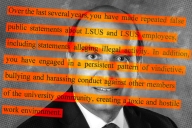You have /5 articles left.
Sign up for a free account or log in.
When Monroe Community College, in Rochester, N.Y., set out in September to find out why more students weren’t taking advantage of early registration, officials found an unexpected source for the problem: communication is good, but students had too much of a good thing.
The college had conducted research that showed students who registered earlier were more likely to succeed: they get financial aid earlier, they’re more likely to get courses at a convenient time, and they have time to buy books and prepare for the first day of class. But while “express enrollment days” for first-time students were a success, continuing students were much less likely to show up.
That wasn’t for lack of communication. In fact, college officials discovered, students were overwhelmed with e-mails, letters, phone calls and postcards about enrollment.
The enrollment management problem led to a “communications audit”: the college gathered every piece of information each department sent to students about signing up for classes. The total was overwhelming, said Kimberley Collins, assistant vice president for academic services at Monroe: in all, the college and its departments had created 286 separate communications about enrollment. Most of those messages -- 60 percent -- were e-mails; 30 percent were letters and 10 percent were phone calls.
Effective communication is crucial for community college students, Collins said. While frequent reminders might help students at a residential college, who are on campus 24 hours a day and can easily respond to reminders by dropping by the right office, community college students are often only on campus for class, and too-frequent reminders are overwhelming and confusing instead of helpful.
“We needed a communication plan for students who are working and juggling other aspects of their lives,” she said. So the college set about combining messages, eliminating duplicates and trying to time reminders effectively.
When it began the audit, the college discovered departments sent notes and e-mails about immunizations, advising, placement tests, involvement on campus and financial aid applications. Often, each task a student needed to complete generated several pieces of communication from several different departments, duplication that college officials decided was unnecessary. Students could get up to 10 letters and e-mails from the college per week -- which, Collins said, made none of them seem particularly important.
Often the timing was off, too, she said. Students started receiving information about advising after they applied to enroll, and again in March and April -- even though advising didn’t begin until April and there was little students could do in advance to prepare. The college replaced the first two communications with a single line in the admissions letter, telling them they should expect information about advising in the spring.
The college began to combine information in other ways, listing several “action items” -- with a specific format, such as red ink or in a bulleted list -- in each communication so that students had a to-do list. Officials avoided sending e-mail to students’ personal accounts, since the accounts too often were outdated or ignored. And they found postcards were particularly effective, since other members of the students’ families would sometimes see them too and remind the students to take action.
The college has also began to target communications based on student characteristics. First-time entering students who just graduated from high school are often the easiest to communicate with, Collins said. Other students, such as nontraditional students or employees seeking training under the Workforce Investment Act, require different, and sometimes more specific, communications.
The project has already seen results. The college used have open hours for placement exams. But those communications didn’t give students a specific action to take, Collins said. This year, the college instituted appointments instead. The number of students taking the exams during their April break increased 50 percent.
And the push for early registration has worked, too. Registrations for the fall are up 30 percent over last year. “Those students will be ready earlier, and be ready to go,” Collins said.
The next step: a database with information on every communication each student has received from the college -- so that Monroe officials know that a student has already been reminded to complete a FAFSA, or that two phone calls in a week might be too many.
“We communicate about everything you can think of,” Collins said. “People care a lot about what students know. We did not step back and say that, really, for students to succeed, we should get them these communications when they need them and not overwhelm them.”








